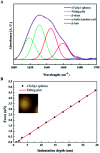Tailor-made spider-eggcase-silk spheres for efficient lysosomal drug delivery
- PMID: 35541844
- PMCID: PMC9078666
- DOI: 10.1039/c8ra00232k
Tailor-made spider-eggcase-silk spheres for efficient lysosomal drug delivery
Abstract
Spider silks are attractive biopolymers due to their excellent mechanical properties and biomimetic potential. To optimize the electrostatic interaction for lysosomal drug delivery, a spider-eggcase-silk protein was genetically engineered using 5× His Tag with a tailor-made isoelectric point of 4.8. By a facile HFIP-on-oil method, silk spheres were assembled as rapidly as 10 s. After the post-treatment of ethanol, silk spheres were determined with an improved compressive modulus by AFM indentation. Under incubation of silk spheres in a Doxorubicin solution, a maximum of 35% loading and average of 30% loading efficiency were determined. In the cytotoxicity experiment, silk spheres exhibited intrinsic biocompatibility and showed good control of the loaded drug in the neutral PBS solution. Significantly, by 96 h, the accumulative drug release at pH 4.5 was approximately 4.5-fold higher than that at pH 7.4. By conducting the platelet adhesion and hemolysis assay, Doxorubicin-loaded silk spheres exhibited good hemocompatibility. To further demonstrate this release behavior, within 24 h, Doxorubicin-loaded silk spheres were efficiently delivered to lysosomes and then released the payload to the nuclei of Hela cells.
This journal is © The Royal Society of Chemistry.
Conflict of interest statement
There are no conflicts to declare.
Figures






Similar articles
-
Facile preparation of recombinant spider eggcase silk spheres via an HFIP-on-Oil approach.Int J Biol Macromol. 2018 Sep;116:1146-1152. doi: 10.1016/j.ijbiomac.2018.05.126. Epub 2018 May 18. Int J Biol Macromol. 2018. PMID: 29782985
-
Bioengineering the spider silk sequence to modify its affinity for drugs.Int J Nanomedicine. 2018 Jul 20;13:4247-4261. doi: 10.2147/IJN.S168081. eCollection 2018. Int J Nanomedicine. 2018. PMID: 30050299 Free PMC article.
-
Functionalized spider silk spheres as drug carriers for targeted cancer therapy.Biomacromolecules. 2014 Aug 11;15(8):2971-81. doi: 10.1021/bm500591p. Epub 2014 Jul 7. Biomacromolecules. 2014. PMID: 24963985
-
[Engineered spider silk: the intelligent biomaterial of the future. Part II].Postepy Hig Med Dosw (Online). 2011 Jun 17;65:389-96. doi: 10.5604/17322693.948968. Postepy Hig Med Dosw (Online). 2011. PMID: 21734323 Review. Polish.
-
Recombinant spider silk proteins for applications in biomaterials.Macromol Biosci. 2010 Sep 9;10(9):998-1007. doi: 10.1002/mabi.201000071. Macromol Biosci. 2010. PMID: 20602494 Review.
Cited by
-
Bioengineered elastin- and silk-biomaterials for drug and gene delivery.Adv Drug Deliv Rev. 2020;160:186-198. doi: 10.1016/j.addr.2020.10.008. Epub 2020 Oct 17. Adv Drug Deliv Rev. 2020. PMID: 33080258 Free PMC article.
-
Preparation and characterization of a iRGD-modified recombinant spider silk particles for antitumor polypeptide drug delivery into cancer cells.BMC Biotechnol. 2025 Aug 27;25(1):88. doi: 10.1186/s12896-025-01023-y. BMC Biotechnol. 2025. PMID: 40866866 Free PMC article.
-
Delivering on the promise of recombinant silk-inspired proteins for drug delivery.Adv Drug Deliv Rev. 2023 Jan;192:114622. doi: 10.1016/j.addr.2022.114622. Epub 2022 Nov 19. Adv Drug Deliv Rev. 2023. PMID: 36414094 Free PMC article. Review.
References
-
- Herrmann J. Bodmeier R. J. Controlled Release. 1995;36:63–71. doi: 10.1016/0168-3659(95)00051-9. - DOI
LinkOut - more resources
Full Text Sources
Miscellaneous

